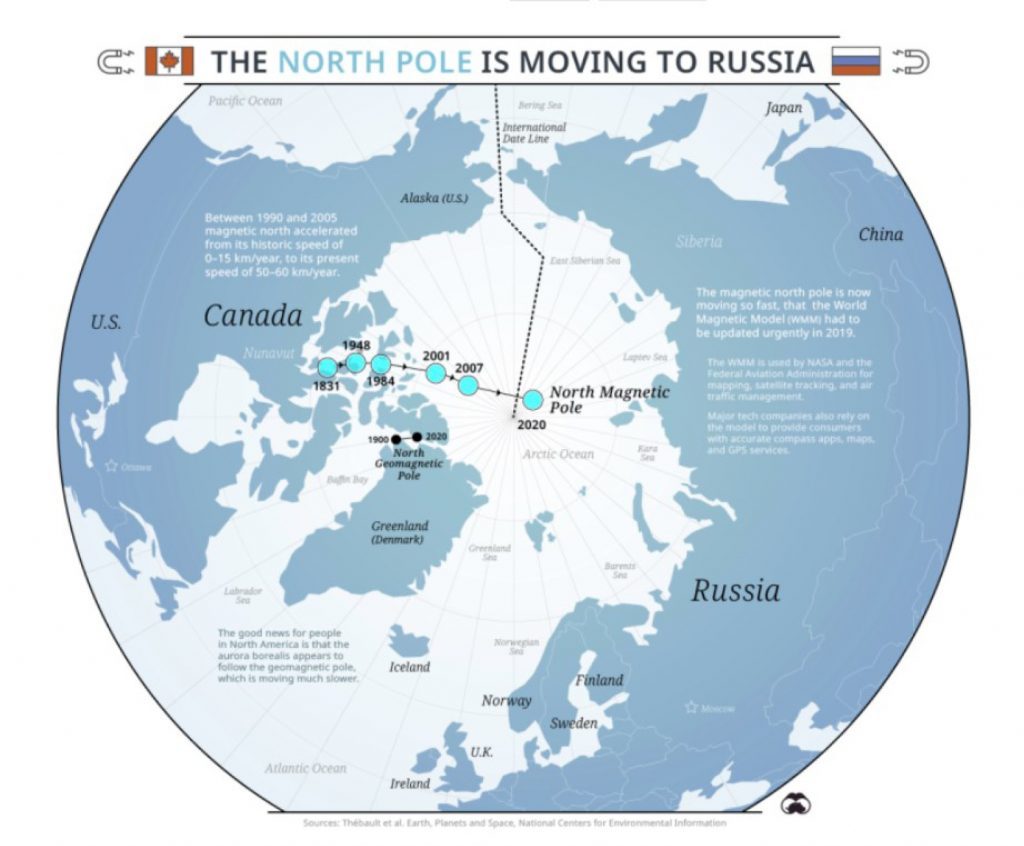There are three kinds of “norths” – Magnetic, True and Grid. Why are there differences between them? This column is about that.
The small English village of Langton Matravers, on the Dorset coast of the United Kingdom, until recently had just one small claim to fame. In 1914, a young Ian Fleming, later the author of the James Bond novels, attended prep school there. But on November 2, 2022, Langton Matravers wrote itself another footnote in the history books, for it was here that the “triple alignment” made landfall in Great Britain.

Dancing Ledge in Langton Matravers, Dorset, close to where the “triple alignment” came ashore on November 2, 2022
Three Kinds of North
While maybe evoking a recipe or a school lesson, it is a phenomenon that delights cartographers everywhere. Langton Matravers made mapping history when true (or geographic) north, magnetic north, and grid north aligned for first time in recorded mapping history. It was an event that may not recur for several centuries, if ever.
True north
is the easiest of the three to explain. This is the direction of the place where all lines of longitude converge – “true” north, full stop.
Magnetic north
is the direction your compass actually points to. Not only is this different from true north, it also moves. The position of magnetic north shifts in response to changes in the Earth’s liquid outer core. In your boat, it is influenced heavily by any and all magnetic or ferrous materials, creating Deviation – but more on that below.
Grid north
is the direction north on a flat map. Since the Earth is a globe, grid north will be slightly different from true north, except for a baseline. For maps produced by Great Britain’s national mapping agency, Ordnance Survey (OS), this baseline, also known as the graticule line, is two degrees west of the Prime Meridian at Greenwich, England.
When you’re using a compass to navigate, it’s important to know the difference between grid north and magnetic north, a difference also known as the “grid magnetic angle”, which is derivative of what we Yanks call Variation (the difference between True and Magnetic norths.) That’s why many topographic maps, including those produced by both the OS and the USGS, indicate the difference between these three different norths.
A Mecca for Map Nerds
Since 2014, and for the first time since the 1660s, the orientation of magnetic north in Britain has been moving east, in the direction of the OS baseline. Grid north passes right through Langton Matravers. Along this line, true north and grid north are already in alignment. And now, due to the movement of the north magnetic pole, magnetic north is in alignment as well.
In an abundance of care: the alignment is the point where the three “north” lines cross – the point where one line (the direction of magnetic north) intersects with the other two (which are lying on top of each other right there).
If you go to Langton Matravers now — as many map nerds have, according to reports in the British press — your compass will point toward magnetic north, true north, and grid north all at the same time. But the village’s second claim to fame will be brief. Since the north magnetic pole keeps moving, so will the point where it intersects with 2° W.
Slowly but inevitably, that point will be traveling north across Britain. Right about now (Christmas 2022), it will already be in nearby Poole, about 10 miles further north. Thus the mantle of “Triple Alignment” passes to Poole. The triple alignment will continue up across England, crossing Britain’s second city Birmingham, until it dips back into the sea, at Berwick-upon-Tweed in the north of England, around August 2025. It will re-emerge at Drums, north of Aberdeen, around May 2026 and, after a short stint in Scotland, leave the UK from Fraserburgh, also in Aberdeenshire, around July 2026. The longer the timescale, the more unpredictable the movements of the north magnetic pole. Perhaps the “triple alignment” will one day return to Britain’s shores. But it could easily be several centuries before that ever happens.
This is the first time in history that true, magnetic, and grid north are in “triple alignment” in the UK. Let’s qualify that: the first time in recorded cartographic history. The Ordnance Survey came up with the National Grid system for its maps only in 1935.

According to this map, the north magnetic pole has been moving from Canada to Russia since at least 1831. The speed of movement increased from up to 15 km (about 9 mi) per year until 1990 to between 50 and 60 km (31-37 mi) per year. The magnetic north pole is now actually quite close to the actual (“true”) north pole. Credit: Visual Capitalist
What is Deviation?
Frankly, more important than Variation to the average boater is Deviation, defined as the sum of all the forces within your boat that keeps your compass from pointing to Magnetic North. What? Case in point: a number of years ago, I was doing USCGAux vessel exams at a local marina when one skipper came up to me and asked me if I could look at his compass because it wasn’t working properly.
Now, fixing an errant compass is a relatively complicated process that requires specialized hardware, but away I went with this skipper to see if I could at least isolate the problem. We stepped on his boat and, just before taking his seat at the helm, he removed his wallet (which held his police badge within) from his hip pocket and placed it next to his compass. While he was fumbling with the boat keys, I literally watched his compass clock around and point at his wallet/police badge! I asked him, “Skipper, why do you put your wallet there?” He said, “It kills my sacroiliac if I sit on my wallet!” I said, “Keep your eye on your compass while I move your wallet.” As I lifted it away from the compass, the compass clocked back and pointed to Magnetic North. “You fixed my compass!” No, I simply removed a source of Deviation.
Metallic objects (or magnetic objects like radio speakers) near your compass will “fool” it into thinking that that object is Magnetic North. How can you determine the Deviation of your compass? Well, if you have a GPS it’ll be easy. All you need is a mile or so of calm water and you can run down the rhumblines of the four cardinal points and record the differences between what the physical compass is reading from the GPS course you are running.
Of interest, Deviation “deviates” differently at a given compass course so you need to check at least the four cardinal courses (when we develop our deviation tables for new boats, we measure at least sixteen compass headings.) You need to know what your boat’s compass Deviation is so that, if you do have to use your compass in lieu of your GPS, you can compensate appropriately. Over enough distance, even a degree or two can add up to significant differences.
If you don’t have a GPS it’s a bit more complicated, but it can be done. Get your paper charts out, and mark a rhumbline between two points that lie at a given magnetic course between each other. Run down that line and record what your compass is reading versus what your paper chart told you the compass should be registering. The difference is Deviation.
Many thanks to “BIGThink” (bigthink.com), “STRANGE MAPS #1178 — November 11, 2022” and Julian Hemsted for socializing this story and from which this column liberally sources!
If you are interested in being part of USCG Forces, email me at JoinUSCGAux@aol.com or go directly to the U.S. Coast Guard Auxiliary “Flotilla Finder” at cgaux.org/units.php and we will help you “get in this thing . . .” ■
The Captain of the Port and Sector Commander for U.S. Coast Guard Sector Long Island Sound is Captain Elisa Garrity. CAPT Garrity is responsible for all active-duty, reservist, civilian and auxiliary Coast Guard personnel within the Sector. As a Commodore in the U.S. Coast Guard Auxiliary First District, Southern Region, Vin Pica works closely with CAPT Garrity and her staff to promote boating safety in the waters between Connecticut, Long Island and 200 nautical miles offshore. Sector Long Island Sound Command Center can be reached 24 hours a day at 203-468-4401.




